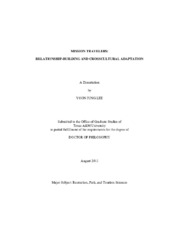| dc.description.abstract | Since 1992, the number of short-term mission (STM) travelers has exponentially increased for more than a decade. The purpose of STMs is to spread religious messages to local residents. In order to spread the word of God, STM travelers attempt to interact with local residents. They want to communicate with local residents in the host community and build a relationship with them. Therefore, for STM travelers their relationship with local residnets really matters. Many tourism scholars have argued that hosts-tourists interaction heavily influences both tourists and hosts. In spite of the increased popularity and the importance of host-tourist interaction in the context of STMs, STMs have received relatively little attention from the tourism research field.
Accordingly, the purpose of this study is to understand short-term mission travelers' interaction with local residents within four existing theories: the theory of leisure and tourist motivation, the theory of cultural hegemony, the gift-exchange theory, and the integrative theory of cross-cultural adaptation. To reach this research aim, this study used a qualitative research design rooted in the constructivist paradigm. A total of 43 STM travelers participated in the interview of this study. Considering the concept of the cultural distance between the participant's home culture and the host culture, American and Korean STM travelers who visited Cambodia or Thailand were recruited. Also, to understand the process of participant's relationship-building and cross-cultural adaptation, both pre- and post-interviews with 26 participants were conducted.
The results showed that STM travelers sought personal and interpersonal rewards from the trip, which supports the theory of leisure motivation. Also, this type of travel had similarities with alternative, mass, and volunteer tourism in terms of tourist motivation. Regarding the theory of cultural hegemony, hegemonic power was exercised through STM travelers' work. STM travelers took advantage of an opportunity to provide what locals wanted as an opportunity to spread their religious message. Furthermore, identified conflicts between Christianity and the local culture support the existence of cultural hegemony. Concerning the relationship-building process of STM travelers, the results suggested that STM travelers built their relationship with local people and God by providing a gift to them and positively evaluating receivers' responses. In terms of the theory of cross-cultural adaptation, this study found support for this theory as successful intercultural adaptation led to a personal transformation in travelers. Finally, cultural distance was considered as a dimension of the intercultural adaptation theory. Regarding the perceived cultural distance, American mission travelers reported cultural distance with the host culture whereas Korean mission travelers expressed a cultural similarity to the host cultures rather than cultural difference. | en |


